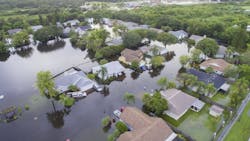The inconvenient truth about climate change is nothing can escape it. Properties are subject to more intense forces of nature, including parts not exposed to the elements—like the plumbing system. Plumbers should learn how to adapt water heaters, pipes, faucets and fixtures (including, toilets, showers, tubs) and appliances such as washing machines and dishwashers, to a warmer world. They must prioritize making homes more climate-resilient as soon as possible.
How Can Climate Change Affect Plumbing Systems?
Climate change threatens plumbing’s structural integrity and functionality in several ways.
Flooding
Places usually hit by heavy downpours may get stronger storms with larger volumes of rainwater. Even high-capacity municipal drainage systems cannot keep deluges from submerging properties.
Low-lying areas are not the only ones susceptible to flooding. Towns near bodies of water are more prone to flash floods. Urban environments are at higher risk of flooding because they have less green space and vegetation to absorb water. The Southwest is a historical flash flood hot spot, but the region may see 10.5% more events due to climate change.
Severe floods eventually recede, but not without clogging drains and damaging electric appliances first. Floodwater brings silt, debris and other materials that can build up in drains and block water flow. Flooding can also result in sewer backup and cause wastewater to enter the property, exposing occupants to various pathogens and spreading diseases.
Moreover, the pressure from the flood can break pipes, leading to water leakage and waste. The electrical components of plumbing components can short-circuit underwater, which can damage appliances or render them unsafe to use.
Freezing Temperatures
Anthropogenic global warming—the kind of greenhouse effect people directly or indirectly cause—can also lead to extreme cold weather events. Rising temperatures are melting Arctic ice and, paradoxically, exacerbating colder weather conditions in the middle latitudes—a region where the United States belongs.
American property owners not used to subzero temperatures are generally ill-prepared to stop pipes from freezing when the outside temperature reaches 32° F. The water flowing through them will expand as it gets colder. The chances of the plumbing bursting increase at 20 degrees, causing old, exposed and uninsulated pipes to rupture.
Saltwater Intrusion
Experts project the sea level along the American coastline to rise by 10-12 inches from 2020 to 2050. Coastal flooding is more devastating than typical floods. It can erode building materials, especially those of waterfront properties, disrupt essential public services and contaminate drinking water sources.
The East Coast is highly vulnerable to coastal flooding. Sewells Point, Virginia, had 12.1 flood days yearly from 2013 to 2022, exceeding the flood threshold more than any US location. Boston, Galveston, Texas, Battery, New York, Atlantic City, New Jersey, Lewes, Delaware, and Bar Harbor, Maine, also had more frequent coastal flooding events.
On the West Coast, coastal floods have become more common in multiple California and Washington cities and towns, including Los Angeles, San Diego and Seattle.
How to Make Plumbing Systems Climate-Resilient
Durable and well-thought-out plumbing infrastructure is a must to make properties more climate-resilient. Plumbing professionals can do four things to take the lead.
1. Follow Advanced Building Standards
Bringing properties up to code is a given. However, many modern building regulations aren’t climate-aware—they do not yet consider the effects of long-term anthropogenic global warming.
Only some states and local governments regularly modernize their policies to compel builders to adopt better construction practices and property owners to maintain structures more meticulously.
A notable example is Florida, where the State Senate recently passed Bill 4-D in 2022 to make multifamily buildings more resistant to severe storms. The law may be a reaction to the deadly Surfside condominium collapse in 2021. Nevertheless, Floridian policymakers considered the event a wake-up call to address the state’s crumbling infrastructure and make structures more resilient to natural and human-made disasters.
Unfortunately, states and municipalities less prone to catastrophes tend to be laggards regarding climate change-related building code reform. Construction professionals should go the extra mile and study relevant updates to model building standards. Some of the organizations that set the trend include:
● American Society of Civil Engineers
● ASTM International
● International Code Council
● The International Association of Plumbing & Mechanical Officials (IAPMO)
● National Fire Protection Association
Understanding what building standards developers recommend matters to offer expert advice regarding plumbing design. Being ahead of the curve pays dividends in terms of business and climate resilience.
2. Use Corrosion-Resistant Pipes
Saltwater corrosion resistance must be the paramount consideration in coastal areas. Plastic piping is a favorite choice, but some iron alloys known to survive in marine environments can be good options, too.
Chlorinated polyvinyl chloride and cross-linked polyethylene are the best nonmetal candidates for water supply lines. Polyvinyl chloride handles wastewater well, although it is more common in Europe than in the US. Cast iron has a solid reputation for withstanding saltwater corrosion among metal waste line materials. Galvanized steel is durable, especially when the saltwater is temperate since warmer seawater corrodes its zinc coating faster.
3. Specialize in Grey Water Treatment
Grey water recycling is sustainable but inadequate. Untreated clean wastewater is suitable only for deep watering outdoor greenery. Grey water through a filtered system has expanded irrigation use cases, producing a safe output for ornamental and edible plants.
Untreated and filtered systems are eco-friendly but not climate-resilient. A treated grey water system fits the bill better, for its coarse-to-fine filter can eliminate fecal matter. This plumbing equipment kills pathogenic organisms with ultraviolet light and keeps its output in a gas-tight container. The result is clean grey water suitable for indoor and outdoor uses, conserving more drinking water.
4. Install Water-Efficient Fixtures
In some areas, anthropogenic global warming can cause frequent, extended dry spells and heat waves. Minimal precipitation heavily impacts the American West.
The Colorado River basin has been undergoing aridification, a process where the soil increasingly loses moisture due to long-term weather change, for over 20 years. Lake Mead and Lake Powell—large reservoirs that provide water and electricity to millions—are drying up. They also supply irrigation water for agriculture, which can lead to food shortages when unreplenished.
Dwindling water resources is a cause for concern. Places used to arid and semi-arid climates have found a way to get by. For instance, Israel desalinates 75% of its drinking water and repurposes 90% of wastewater.
Due to the size of the American population and economy, the US may be unable to replicate Israel’s sustainability efforts at a government level. Still, dramatic water conservation methods can be followed at home.
Every climate-resilient plumbing component must be water-efficient. Recommending green plumbing staples—such as low-flow faucets and showerheads, smart showers, dual-flush toilets and front-loading clothes washers—can move the needle in conservation. For example, a water-efficient washing machine saves 27 gallons per load when cleaning seven loads of laundry weekly.
Climate-Resilient Plumbing Makes Climate-Resilient Structures
Climate change is bad news from any angle. Its only silver lining is it happens in slow motion, buying adaptive construction professionals time to devise strategies to build more resilient plumbing designs.
Rose Morrison is a freelance writer who covers construction, home improvement, and contracting topics. She is also the managing editor of Renovated.com, a site dedicated to the latest trends in the home industry. She has a passion for innovative technologies that are making the home industry sustainable and efficient. Check out Renovated.com to see more of her work.
About the Author

Rose Morrison
Rose Morrison is a freelance writer who covers construction, home improvement, and contracting topics. She is also the managing editor of Renovated.com, a site dedicated to the latest trends in the home industry. She has a passion for innovative technologies that are making the home industry sustainable and efficient. Check out Renovated.com to see more of her work.
